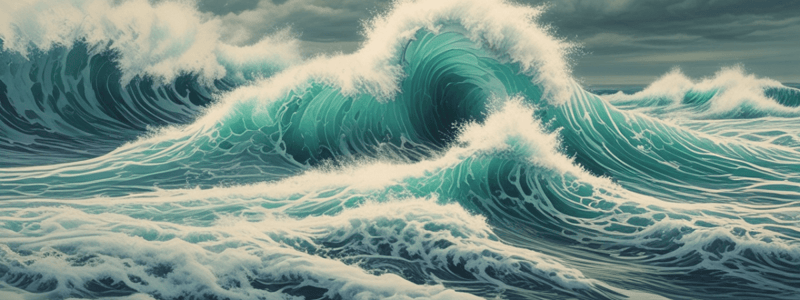Podcast
Questions and Answers
What phenomenon causes a wave to break?
What phenomenon causes a wave to break?
- Decreased wavelength
- Opposing and combining wave systems (correct)
- Increased peak height
- Sloping water beds
Which natural process is responsible for bending of waves due to varying water depths?
Which natural process is responsible for bending of waves due to varying water depths?
- Wave refraction (correct)
- Wave interference
- Wave disruption
- Wave breaking
What happens to the peak heights of waves as they move toward a beach?
What happens to the peak heights of waves as they move toward a beach?
- They decrease
- They increase (correct)
- They stabilize
- They disappear
What term describes the regular wave motions formed as seas propagate away from their area of origin?
What term describes the regular wave motions formed as seas propagate away from their area of origin?
What is the primary factor that causes ocean surface waves?
What is the primary factor that causes ocean surface waves?
In the context of ocean waves, what is a crest?
In the context of ocean waves, what is a crest?
What does the wavelength of an ocean wave represent?
What does the wavelength of an ocean wave represent?
Which statement best describes the horizontal movement of water particles in an ocean wave?
Which statement best describes the horizontal movement of water particles in an ocean wave?
What makes ripples appear on smooth water when the wind blows?
What makes ripples appear on smooth water when the wind blows?
What characteristic describes the time interval between the arrival of consecutive crests at a stationary point?
What characteristic describes the time interval between the arrival of consecutive crests at a stationary point?
Why are tsunamis not visible in deep water?
Why are tsunamis not visible in deep water?
What is the main cause of the waves on an ocean?
What is the main cause of the waves on an ocean?
Which property of wave motion explains how waves move through different mediums?
Which property of wave motion explains how waves move through different mediums?
What happens when a wave goes through a small hole and has a flared out geometric shadow of the slit?
What happens when a wave goes through a small hole and has a flared out geometric shadow of the slit?
Why can we hear sound around a corner?
Why can we hear sound around a corner?
What is the outcome when waves, whether physical or electromagnetic, bounce from a surface back toward the source?
What is the outcome when waves, whether physical or electromagnetic, bounce from a surface back toward the source?
Flashcards are hidden until you start studying
Study Notes
Ocean Waves
- Ocean waves separate into swells based on direction and wavelength as they propagate away from their origin.
- Rogue waves, also known as freak waves, can occur and reach heights of up to 30 meters.
Wave Breaking
- Wave breaking occurs when a wave's base can no longer support its top, causing it to collapse.
- This can happen when a wave runs into shallow water or when two wave systems oppose and combine forces.
- The slope or steepness ratio of a wave can also cause breaking.
Refraction
- Refraction is the bending of waves due to varying water depths underneath.
- The part of a wave in shallow water moves slower than the part of a wave in deeper water.
Ocean Surface Waves
- Ocean surface waves are caused by wind and are also referred to as wind waves.
- They can travel thousands of miles before reaching land.
- Waves range in size from small ripples to huge rogue waves.
Wave Characteristics
- Wave height is the difference between the elevations of a crest and a neighboring trough.
- Wavelength is the distance between repeating units of a propagating wave of a given frequency.
- Crest is the point on a wave with the greatest positive value or upward displacement in a cycle.
- Trough is the opposite of a crest.
Wave Formation
- Four factors influence the formation of wind waves: wind speed, fetch, time, and water depth.
- The greater each of these variables, the larger the waves.
Types of Wind Waves
- Three different types of wind waves develop over time: capillary waves, seas, and swells.
- Capillary waves are ripples that appear on smooth water when the wind blows.
- Seas are larger-scale, often irregular motions that form under sustained winds.
- Swells are regular wave motions that form as waves separate according to direction and wavelength.
Wave Properties
- Waves are a means by which energy travels.
- Waves reflect, refract, and diffract energy.
- Diffraction is when a wave goes through a small hole and has a flared out geometric shadow of the slit.
- Reflection is when waves bounce from a surface back toward the source.
- Refraction is when waves are deflected when they go through a substance, changing the angle of their general direction.
Studying That Suits You
Use AI to generate personalized quizzes and flashcards to suit your learning preferences.




